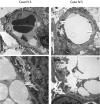Coinheritance of COL4A5 and MYO1E mutations accentuate the severity of kidney disease
- PMID: 25739341
- PMCID: PMC4536279
- DOI: 10.1007/s00467-015-3067-9
Coinheritance of COL4A5 and MYO1E mutations accentuate the severity of kidney disease
Abstract
Background: Mutations in podocyte and basement membrane genes are associated with a growing spectrum of glomerular disease affecting adults and children. Investigation of familial cases has helped to build understanding of both normal physiology and disease.
Methods: We investigated a consanguineous family with a wide clinical phenotype of glomerular disease using clinical, histological, and new genetic studies.
Results: We report striking variability in severity of nephropathy within an X-linked Alport syndrome (XLAS) family. Four siblings each carried a mutant COL4A5 allele, p.(Gly953Val) and p.(Gly1033Arg). Two boys had signs limited to hematuria and mild/moderate proteinuria. In striking contrast, a sister presented with end-stage renal disease (ESRD) at 8 years of age and an infant brother presented with nephrotic syndrome, progressing to ESRD by 3 years of age. Both were subsequently found to have homozygous variants in MYO1E, p.(Lys118Glu) and p.(Thr876Arg). MYO1E is a gene implicated in focal segmental glomerulosclerosis and it encodes a podocyte-expressed non-muscle myosin. Bioinformatic modeling demonstrated that the collagen IV-alpha3,4,5 extracellular network connected via known protein-protein interactions to intracellular myosin 1E.
Conclusions: COL4A5 and MYO1E mutations may summate to perturb common signaling pathways, resulting in more severe disease than anticipated independently. We suggest screening for MYO1E and other non-COL4 'podocyte gene' mutations in XLAS when clinical nephropathy is more severe than expected for an individual's age and sex.
Figures



References
-
- Mochizuki T, Lemmink HH, Mariyama M, Antignac C, Gubler MC, Pirson Y, Verellen-Dumoulin C, Chan B, Schröder CH, Smeets HJ, Reeders ST. Identification of mutations in the alpha 3(IV) and alpha 4(IV) collagen genes in autosomal recessive Alport syndrome. Nat Genet. 1994;8:77–81. doi: 10.1038/ng0994-77. - DOI - PubMed
-
- Jais JP, Knebelmann B, Giatras I, De Marchi M, Rizzoni G, Renieri A, Weber M, Gross O, Netzer KO, Flinter F, Pirson Y, Dahan K, Wieslander J, Persson U, Tryggvason K, Martin P, Hertz JM, Schröder C, Sanak M, Carvalho MF, Saus J, Antignac C, Smeets H, Gubler MC. X-linked Alport syndrome: natural history and genotype-phenotype correlations in girls and women belonging to 195 families: a “European community Alport syndrome concerted action” study. J Am Soc Nephrol. 2003;14:2603–2610. doi: 10.1097/01.ASN.0000090034.71205.74. - DOI - PubMed
Publication types
MeSH terms
Substances
Grants and funding
LinkOut - more resources
Full Text Sources
Other Literature Sources

